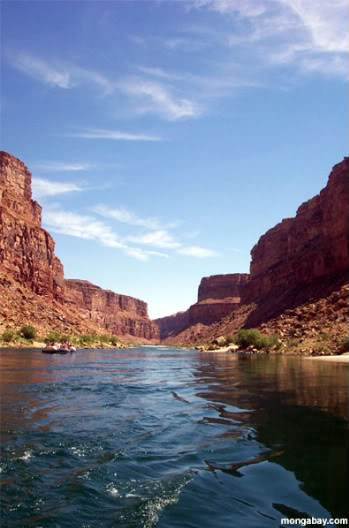|
|
Feeding the water habits of such major cities as Los Angeles, Las Vegas, and Phoenix, in addition to providing irrigation waters for the entire Southwestern United States, has stretched the Colorado River thin. The river no longer consistently reaches the sea as it once did. Now a new study warns that the Colorado River system, which has proven dependable for human use throughout the 20th Century, may soon experience shortages due to global warming.
Two climate researchers at Scripps Institution of Oceanography, UC San Diego conclude in a study that if global warming causes the region to become even drier than the Colorado River will be unable to meet current human demand 60-90 percent of the time by the middle of the century.
 The Colorado River as seen from the inside of the Grand Canyon. Photo by: Rhett A. Butler. |
“All water-use planning is based on the idea that the next 100 years will be like the last 100,” said Scripps research marine physicist Tim Barnett, a co-author of the report published in Proceedings of the National Academy of Sciences. “We considered the question: Can the river deliver water at the levels currently scheduled if the climate changes as we expect it to. The answer is no.”
The river would even experience shortfalls under conservative global warming scenarios, coming under current targets by a half-billion cubic meters (or 400,000 acres feet) of water per year 40 percent of the time by 2025. By the later part of the century, the numbers double. Currently an acre foot of water is considered enough for the water consumption of two households every year.
“People have talked for at least 30 years about the Colorado being oversubscribed but no one ever put a date on it or an amount. That’s what we’ve done,” said Barnett. “Without numbers like this, it’s pretty hard for resource managers to know what to do.”
According to reconstructions of past climates in the Southwest, the 20th century was actually one of the wettest centuries in the last 1,200 years. According to tree rings, the Colorado River typically flows lower than it did throughout most of the last century, making current water requirements even more unsustainable down the road.
Conservation and water transfers should make up for the river’s shortfall during most years, say the authors. However, during dry years the shortages for the region could be large.
“Fortunately, we can avoid such big shortfalls if the river’s users agree on a way to reduce their average water use,” said co-author David Pierce. “If we could do that, the system could stay sustainable further into the future than we estimate currently, even if the climate changes.”
CITATION: “Sustainable water deliveries from the Colorado River in a changing climate”. David Pierce and Tim Barnett. Proceedings of the National Academy of Sciences, April 20th, 2009.
Related articles
Revolutionary new theory overturns modern meteorology with claim that forests move rain
(04/01/2009) Two Russian scientists, Victor Gorshkov and Anastassia Makarieva of the St. Petersburg Nuclear Physics, have published a revolutionary theory that turns modern meteorology on its head, positing that forests—and their capacity for condensation—are actually the main driver of winds rather than temperature. While this model has widespread implications for numerous sciences, none of them are larger than the importance of conserving forests, which are shown to be crucial to ‘pumping’ precipitation from one place to another. The theory explains, among other mysteries, why deforestation around coastal regions tends to lead to drying in the interior.
Secretary of Energy warns of dire future for agriculture in California
(02/05/2009) Secretary of Energy Steven Chu warned climate change could severely impact California agricultural industry by the end of the century, reported the Los Angeles Times.
California faces severe drought
(01/30/2009) California appears to be on track for its worst drought since the early 1990s, warned the state’s Department of Water Resources (DWR) following its survey of snowpack and other water resources.